Imagine a world tomorrow where all technology suddenly ceased to exist. No electricity, no cars, no internet, no modern medicine. It’s a stark thought, and one that makes us appreciate our daily conveniences. But if we had to survive, where on Earth would be the most hospitable?
As someone who studies climate and how we interact with it, this hypothetical scenario really makes you think about our fundamental needs: food, water, shelter, and protection from extreme weather. When we strip away our technological crutches, our biology and the natural environment become paramount.
So, what kind of climate would give us the best chance without advanced tools?
The Case for Temperate Climates
Many scientists and survival experts point towards temperate regions. Think of areas with mild winters and warm, but not excessively hot, summers. Why?
- Reliable Food Sources: These climates often support diverse agriculture and animal husbandry. With knowledge and basic tools, humans could grow crops like grains, fruits, and vegetables, and raise livestock for food and resources. The growing seasons are typically long enough to sustain populations.
- Manageable Weather: While they experience seasons, temperate zones generally avoid the extreme, life-threatening conditions found in the tropics (intense heat, humidity, prevalent disease vectors) or the extreme cold of polar regions (hypothermia, lack of food, long periods of darkness).
- Water Availability: Moderate rainfall is common, providing access to freshwater for drinking and agriculture, which is crucial when modern water purification systems are gone.
- Building Materials: Forests are often abundant, offering wood for shelter, fuel, and tools.
Examples of such regions might include parts of Western Europe, the Pacific Northwest of North America, or certain areas in East Asia. These places historically supported large human populations even before widespread industrialization.
Why Other Climates Pose Greater Challenges:
- Tropical Rainforests: While rich in biodiversity, they come with intense heat, high humidity, and a significant risk of diseases transmitted by insects. Finding easily digestible and safe food sources could also be a challenge, and building durable shelters against constant moisture and pests would be difficult.
- Deserts: Extreme heat during the day, frigid temperatures at night, and a severe lack of water make survival incredibly difficult. Sustaining agriculture would be nearly impossible without advanced irrigation.
- Polar Regions: The overwhelming challenge here is the extreme cold and limited food availability for much of the year. Surviving without advanced insulation and heating would be a constant battle against hypothermia.
- Arid/Semi-Arid Regions (beyond deserts): While some areas might support grazing, the scarcity of water and potential for severe droughts would be a major hurdle for reliable food production.
Human Adaptability
It’s important to remember humans are incredibly adaptable. Our ancestors survived and thrived in a vast array of climates. However, without the technological buffer we’ve built, the playing field shifts dramatically. Our physiology is best suited to environments that don’t force us into constant, high-energy battles against extreme heat or cold, and that offer consistent access to food and water.
So, while humans are resilient, a temperate climate would likely offer the most forgiving conditions for rebuilding and sustaining life without the marvels of modern technology. It’s a reminder of how intricately our lives are tied to the natural world around us.

